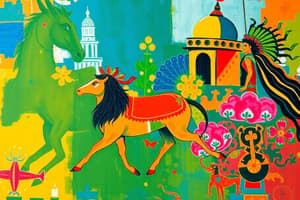Podcast
Questions and Answers
Match the Indian Heritage Sites with the dynasty/empire that built them:
Match the Indian Heritage Sites with the dynasty/empire that built them:
Taj Mahal = Mughal Empire Red Fort = Mughal Empire Hampi Monuments = Vijayanagara Empire Khajuraho Temples = Chandela dynasty
Match the Indian Heritage Sites with their respective locations:
Match the Indian Heritage Sites with their respective locations:
Taj Mahal = Agra, Uttar Pradesh Hampi Monuments = Khajuraho, Madhya Pradesh Red Fort = Old Delhi, Delhi Khajuraho Temples = Hampi, Karnataka
Match the Indian Heritage Sites with their notable features:
Match the Indian Heritage Sites with their notable features:
Taj Mahal = White marble and intricate inlays of precious stones Red Fort = Red sandstone walls and Diwan-i-Khas Hampi Monuments = Ruins of temples, palaces, and marketplaces Khajuraho Temples = Intricate carvings and sculptures depicting Hindu mythology
Match the Indian Heritage Sites with the century they were built in:
Match the Indian Heritage Sites with the century they were built in:
Match the Indian Heritage Sites with their architectural styles:
Match the Indian Heritage Sites with their architectural styles:
Match the Indian Heritage Sites with the type of structures they consist of:
Match the Indian Heritage Sites with the type of structures they consist of:
Match the Indian Heritage Sites with their current status:
Match the Indian Heritage Sites with their current status:
Match the Indian Heritage Sites with their notable temples:
Match the Indian Heritage Sites with their notable temples:
Match the Indian Heritage Sites with their builders:
Match the Indian Heritage Sites with their builders:
Match the Indian Heritage Sites with their categories:
Match the Indian Heritage Sites with their categories:
Flashcards are hidden until you start studying
Study Notes
Indian Heritage Sites
Taj Mahal
- Located in Agra, Uttar Pradesh
- Built by Mughal Emperor Shah Jahan in 1653 as a mausoleum for his wife Mumtaz Mahal
- Considered one of the Seven Wonders of the Modern World
- Architecture: Mughal style with Persian, Turkish, and Indian elements
- Features: White marble, intricate inlays of precious stones, and ornate gardens
Red Fort (Lal Qila)
- Located in Old Delhi, Delhi
- Built by Mughal Emperor Shah Jahan in 1648
- Served as the imperial palace of the Mughal Empire for nearly 200 years
- Architecture: Mughal style with Indian, Persian, and European influences
- Features: Red sandstone walls, Diwan-i-Khas, Diwan-i-Am, and Rang Mahal
Hampi Monuments
- Located in Hampi, Karnataka
- Built by the Vijayanagara Empire in the 14th century
- Features: Ruins of temples, palaces, and marketplaces
- Notable structures: Virupaksha Temple, Vitthala Temple, and the Queen's Bath
Khajuraho Temples
- Located in Khajuraho, Madhya Pradesh
- Built by the Chandela dynasty between 950 and 1050 AD
- Features: 25 temples with intricate carvings and sculptures depicting Hindu mythology and erotic art
- Notable temples: Kandariya Mahadeva Temple, Lakshmana Temple, and Vishvanatha Temple
Ajanta and Ellora Caves
-
Ajanta Caves: Located in Aurangabad, Maharashtra
-
Built between 2nd century BCE and 5th century CE
-
Features: 30 Buddhist cave temples with paintings and sculptures
-
Notable caves: Cave 1, Cave 2, and Cave 16
-
Ellora Caves: Located in Aurangabad, Maharashtra
-
Built between 5th and 10th century CE
-
Features: 34 Buddhist, Hindu, and Jain cave temples
-
Notable caves: Kailasa Temple, Dasavatara Cave, and Rameshvara Cave
Other notable Indian heritage sites:
- Mahabalipuram Group of Monuments, Tamil Nadu
- Konark Sun Temple, Odisha
- Fatehpur Sikri, Uttar Pradesh
- Group of Monuments at Pattadakal, Karnataka
- Sundarbans National Park, West Bengal
Studying That Suits You
Use AI to generate personalized quizzes and flashcards to suit your learning preferences.




